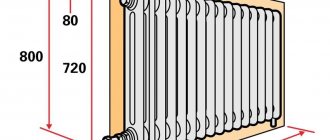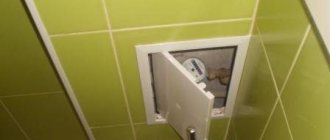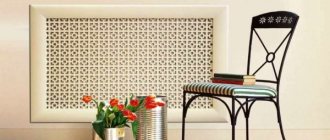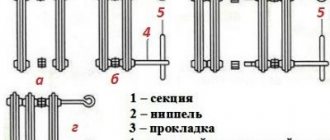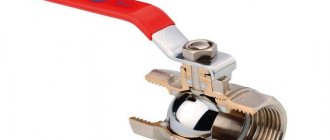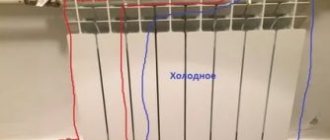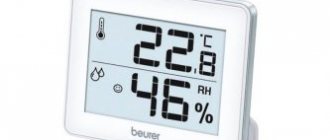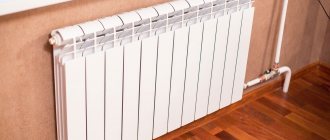How to cover radiators so that they fit perfectly into the overall design of the rooms and do not spoil their design? But with this calculation, of course, to avoid significant losses in the efficiency of radiators? This question arises quite often when completing renovations of an apartment or house. If cast iron radiators of an old model are installed in the heating system, but there is no desire to change them, since they function perfectly, then they can be disguised with decorative screens or grilles.
How to cover radiators
These devices, we repeat, must be made in such a way that they do not interfere with the flow of heat into the room. Therefore, if you plan to make them yourself, you need to carefully consider the design. In addition, such products can be ordered from a furniture workshop, taking measurements from the place where they are installed, or they can be immediately purchased ready-made in specialized stores.
It should be noted that you can choose a model of protective and decorative screen that will not only mask the unsightly appearance of cast iron products, but will even increase the circulation of warm air from the radiators towards the room.
To choose the right screen model, you need to understand the operating principle of heating radiators and some of the patterns of transfer of thermal energy into the room.
Operating principles of heating radiators
The heating radiator, heated by the coolant passing through it, releases heat into the room in two ways. The first is natural convection of heated air. The second is thermal infrared radiation that comes from the surfaces of the heating device.
Scheme of heat transfer by convection currents and direct infrared radiation
Thus, the familiar MS-140 cast iron radiators heat the room with convection currents at low coolant temperatures, that is, when it is still not very cold outside. When the system is brought to a maximum heating temperature of 70 degrees and above, the heat entering the room occurs to a greater extent due to direct thermal radiation from the surfaces of the radiators.
Aluminum batteries (or bimetallic batteries with aluminum external heat exchangers), which have been increasingly installed in residential areas in recent years, operate on the same principle. However, they are able to some extent “adapt” to the existing conditions and the influence of external factors. For example, if there are obstacles to the convection flow of heat into the room (these could be thick curtains or improperly designed decorative screens), then the heat flows inside the devices move to the outer walls of the sections, which have a wider plane. In this case, the battery begins to heat the room with direct radiation.
In order for the heat transfer from the heating system to be maximum, it is necessary to ensure that heat can be supplied to the room in both ways. For this purpose, special decorative grilles are produced that cover only the vertical surfaces of the battery, that is, in such designs there are no upper and lower horizontal panels. This allows heated air to circulate freely, heating the entire volume of the room. And the conditions for infrared radiation transmission can be met in the case where there is perforation on the front side of the screen or the grilles make up at least 50% of the total panel area. The radiator must be completely open at the top and bottom.
You may be interested in information about how many battery sections per 1 square meter need to be installed indoors.
How to close a radiator: interesting ideas
When planning to close a heating radiator, it is necessary to take into account a number of the following conditions:
- Due to the disruption of proper air circulation, the battery efficiency will decrease. This will happen in any case, regardless of the method you choose. The difference lies only in the percentage of thermal energy loss.
- The minimum circulation of convection currents should remain. The deficiency will be reflected in uneven heating of the room and fogging of windows.
- No one is immune from possible leaks and other emergencies. Therefore, all threaded connections and the radiator itself must be within reach. The decor can be a removable or easily dismountable structure.
- You should also consider in advance the possibility of free access to the tap, thermal head and other elements of the heating system.
Painted radiator Source cloudfront.net
Healthy! You can increase the heat transfer coefficient of a heating radiator in a simple way. To do this, a foil material is placed between it and the wall, which will reflect thermal energy toward the house, thereby improving air circulation indoors.
There are many options for hiding a heating radiator in a bedroom, nursery or kitchen. Let's analyze the most popular of them:
- Mounted and attached screens.
- Curtains.
- Coloring.
- Decoration with textiles.
- Coloring, artistic painting.
- Fabric screen.
Several important requirements for decorative screens
In addition to the conditions mentioned above, when choosing a decorative panel, you should take into account several more important points that ensure sufficient heat transfer from heating radiators.
- The material from which the screen or grille is made must have good thermal conductivity. This is a necessary condition so that the heat does not linger in the space between the surfaces of the battery and the panel, but passes freely into the room.
- It is recommended to paint the inside of the decorative panel in a dark color, dark brown or black - this factor will contribute to good absorption of heat emanating from the radiator and transferring it to the room. The front side of the panel can be painted in any shade that best suits the overall color scheme of the room.
The simplest device - a reflective screen made of thin foil insulation - can significantly increase the heat transfer efficiency of radiators
- Another device that will help save thermal energy from unproductive escape into the external wall can be a heat-reflecting screen. It is mounted on the wall, behind the radiator. Most often, foil-foamed polyethylene with a thickness of 3÷5 mm is used as this device. The insulation is fixed with the reflective surface facing outwards. Thus, all the heat emanating from the radiator will be directed towards the room, which will enhance its passage through the decorative panel.
If the radiators have yet to be installed, then instead of thin polyethylene, you can fix foil foam 10 mm thick on the wall. This material will help significantly save on heating costs.
You might be interested in information about what paint is suitable for heating pipes
Purpose of decorative grilles
A well-chosen protective grille should not disturb the harmony of the room. Its task is to become an excellent stylistic addition to the interior and an effective camouflage device behind which an unaesthetic battery is hidden.
The functional purpose of the radiator is to heat the room. Therefore, the protective screen should not interfere with effective heat transfer.
If this element retains heat, the room will become cold, and additional heating sources will have to be used, and this entails an increase in utility bills.
We recommend: A stove being used in a garage: pros and cons, drawings, how to make it yourself, video
But you can choose a grille configuration that will not only hide the radiator, but also increase the flow of heat into the room.
In addition to hiding the surface of the battery, the decorative grille performs protective functions. Firstly, the screen protects the radiator from dust and contamination. Secondly, it doesn't get as hot as a battery. This means that you can touch it without fear of getting burned. This is especially important for families with children or pets.
In addition, the screen can be quickly dismantled for the purpose of prevention, repair or replacement of the heating device.
Efficiently working decorative screen
In order to select or make a screen that will minimally reduce infrared radiation and will not slow down (and sometimes even improve or activate) the circulation of heated air, it is necessary to take into account some nuances:
Unsuccessful option for closing heat exchange devices of the heating system
- Although the design shown in the first illustration looks aesthetically pleasing and is generally functional, it will not allow heated air to flow freely into the room. The wooden grille almost completely blocks access to the heat emanating from the radiators. The upper part of the radiator is also closed, and if it does not have special aerodynamic guides, then the convection of warm air will be extremely difficult.
The other extreme is that there are gaps for IR radiation, but the channels for free convection are almost completely blocked
- This version of the design covering the radiator is more acceptable, since there are sufficiently large gaps between the cladding strips - this will allow direct thermal radiation to freely enter the room. However, it is unsuccessful in that the top and bottom of the grille are closed, which will impede the circulation of air masses. A wide window sill may be convenient for use as a shelf, but it eliminates the creation of a warm air curtain that should block the cold air flows from the window.
An easy-to-use battery screen option that is optimal for passing convection currents. True, the density of capture is still high, and the barrier to thermal radiation is quite significant.
- This grille-screen model can be called a very good option, since the facade panel has many gaps through which the heat emanating from the surfaces of the radiator sections can pass (it would not be advisable to have a more sparse weave). The horizontal upper part of the structure is a frame that will not become an obstacle to circulating air flows. There are no barriers at all to the entry of cooled air from below. In addition, the bottom of the facade panel can be raised when cleaning.
A good option for a camouflage screen.
- Another model of a decorative screen that is suitable for masking any battery. The product is made in the form of an openwork mesh, so it looks light, almost weightless, but at the same time, the panel reliably hides the radiator located behind it. Thanks to the mesh structure of the façade and top panels, the heated air will not encounter obstacles to both direct heat input and the circulation process.
An effective device that can be used to complement the screen design is an aerodynamic visor. This element, installed under the window sill at an angle, will direct the rising hot air towards the room, preventing it from accumulating under the plane of the window sill. Such a visor should run along the entire length of the radiator.
But that's not all. It is recommended to supplement the design with another device - a heat injector. These are two more guide plates curved towards the room along the entire length of the radiator, installed on top along the boundaries of the space between the battery and the decorative screen. This does not interfere with the operation of normal convection flow when the coolant temperatures in the heating system are low. But when the heat is high, it collects all the heat that accumulates between the radiator and the screen, and redirects it into the room with a powerful air flow, creating a kind of thermal curtain. The efficiency of the heat exchange device increases significantly, and thereby largely compensates for the losses arising due to existing obstacles to direct thermal radiation.
The diagram below shows a screen, complemented by an aerodynamic visor, mounted on a radiator, as well as the heated air flows emanating from it:
A diagram of the clever screen design with aerodynamic improvements.
- A - heat-reflecting screen made of foil-coated heat-insulating material, mounted on the wall.
- B - aerodynamic curved canopy, installed under the window sill from its edge to the wall at an angle.
- B - two heat injector blades, fixed in the upper part inside the decorative screen, creating a tapering nozzle in the space between the radiator and the outer casing (screen).
- G - elements of the lattice façade part of the decorative screen.
Thermal direct radiation is shown in the diagram with red dotted lines (item 3), ending with arrows. It is clearly visible that those of them that were initially directed towards the wall are reflected from the foil screen and redirected towards the room. They also heat the decorative panel, which, in turn, also becomes a source of thermal radiation.
Blue arrows show the direction of cooled air (item 1) entering the radiator from below, which then heats up and rises upward, again heading into the room (brown arrows, item 2), which is facilitated by the aerodynamic visor and heat injector.
Battery near the wall: what to do with it?
Let's start with the important things. Maybe this will even be news to some
In general, the fact is that nowadays it is not customary to be shy about radiators. In many modern design projects, batteries are displayed in prominent places. Often they are even emphasized. They are turned into a decorative object or a style-forming element.
So if this is unimportant, if the battery is located in a corner and does not bother anyone, you can simply buy a new beautiful radiator and not try to disguise it.
The second thing I would like to remind you of. Do not close the radiator tightly. It must perform its main function - heating. If you hide the battery in a cabinet behind solid doors, its heating efficiency will significantly decrease. It is necessary to leave at least the top and bottom of the structure or the entire facade free for air movement (by making it perforated).
Well, now to other solutions.
Types of decorative screens by material and design
Decorative screens for heating radiators are divided according to two criteria - design features and material of manufacture. Before moving on to their consideration, it is necessary to note two more important factors that you need to pay attention to when choosing these products:
- In winter, when radiators heat up to high temperatures, strong convection currents are created. That is, cold currents tend to the radiators along the floor, pushed by warm air, carrying dust with them. Dust particles will inevitably settle not only on the radiators themselves, but also on the surface of the screen or grille. Therefore, it is necessary to choose a product from a material that is easy to wet clean.
- In addition to being decorative, the screens also have a protective function, since it covers the fins of the radiators, reducing the risk of traumatic situations. This is especially important to take into account when choosing the material for making panels if small children live in the house, and cast iron radiators with their characteristic angular shapes are installed in the system.
Design features of decorative screens
Decorative masking panels are divided according to the method of attaching them to radiators. Today there are box-type screens and wall-mounted products.
Decorative box with a very high vacuum grid on the facade panel. Paths for air convection currents have also been thought out. The design can be considered successful.
- Box screens
They are made in the form of a lattice enclosed in a frame. This type of product is used when it is necessary to hide the unsightly appearance of the radiator, and sometimes even the heating circuit pipes. The boxes are lined up along the entire window sill or cover only the radiator.
This battery closure option shows perhaps good functionality as a piece of furniture. But you can hardly expect adequate heat transfer from the hidden radiator.
Quite often the masking box is turned into a continuation of the window sill or even into a desk or cabinet. However, as mentioned above, such designs significantly reduce the flow of heat into the room.
Screen boxes can have opening doors, which is convenient when cleaning and adjusting the temperature of the coolant in a specific room. The version shown in the photo lacks the upper grille for the free exit of heated air or the aerodynamic visor mentioned above.
- Hanging grid screens
They can be equipped with an upper horizontal panel with a decorative grille installed in it, or consist only of the front part.
A hinged grid screen is an excellent solution, as it leaves the space under the battery and its sides open. The heated air has the ability to circulate. There are no particular obstacles to direct thermal radiation through the façade panel.
The first ones are used to disguise batteries installed in a niche or areas not covered by a window sill. These screen options are hung directly on the radiator sections.
Mounted screen models are installed on radiators installed in any way, that is, both in a niche or under a window sill, and on devices protruding from the wall.
- Flat screens
Wall-mounted, they are most often installed on radiators that are not covered by a window sill, but can be used to cover radiators installed in a niche.
Mounting a flat glass screen on the wall.
If this option is planned to be used to disguise batteries recessed into the wall, then it is necessary to leave gaps in the upper and lower parts of the niche for the free circulation of heated air masses.
By the way, many people prefer solid facade screens for the reason that they best hide the “unflattering” appearance of the batteries. One can argue with this - a neat grille, especially one that has a certain “pattern”, even with a fairly large vacuum, attracts the eye, and the sections shining through it become almost invisible. But at the same time, the efficiency of direct thermal radiation is incomparably higher.
Types of screens by material of manufacture
Both screens and grilles are made from different materials. To decide on the choice of products according to this criterion, it is necessary to consider their characteristic features. It is especially important to take into account the temperature regime in which the heating system operates in winter, as well as the resistance of the material to thermal loads and its environmental friendliness.
- Metal grating screens
This is a perforated sheet of metal without a frame or fixed in a metal frame, and having a protective and decorative enamel coating. Such screens are made using stamping technology. They may simply have geometrically correctly located holes (slots), or the perforation may even create one or another simple pattern.
Metal mesh screen without frame.
Such grilles do not completely cover the radiators, allowing air flows to circulate freely throughout the room. The screens look quite neat and aesthetically pleasing. In addition, the product meets environmental standards, and the manufacturing material is resistant to high temperatures that may arise during operation, warms up well and itself becomes a source of thermal radiation.
The enamel coating is applied to the surfaces of metal gratings using the powder coating method. Therefore, the metal is not exposed to corrosion, and the “fresh” color is preserved for a long time without fading.
Metal versions of screens are produced both in a hinged version and in the form of boxes.
In addition, this type of screen will well protect the child from serious injuries if he accidentally falls near a cast iron battery.
The screens are easy to install at the site of operation and are durable. According to the design, the product can be selected to suit any interior style. If desired, or if the color scheme of the interior changes, the metal grille can be easily repainted in the desired shade.
Metal screen grilles have a relatively affordable price, despite their excellent characteristics.
It should be noted that panels can be manufactured to individual orders according to specific dimensions provided by the customer, as well as taking into account the specific configuration and location of radiators.
Prices for decorative metal screen:
decorative metal screen for radiators
- Screen-grids made of polyvinyl chloride (PVC)
This version of the panels is made entirely of plastic or in a combined version, in combination with natural or artificial rattan. In such PVC panels, a frame is made in which a rattan mesh is fixed. Plastic can have a coating that imitates various materials - these can be different types of wood, stone, metallic or fabric weaving.
PVC has lower thermal conductivity than metal, which is why it is combined with natural rattan, which conducts heat well.
Screen-box with a PVC lattice panel installed in it.
Polyvinyl chloride is resistant to fairly high temperatures and can be easily cleaned from dust using a vacuum cleaner or wet cleaning. The material does not emit toxic fumes and will provide good protection against injury for a small child.
The screens have a fairly aesthetic appearance and can be matched to any interior design.
The cost of PVC products is more affordable than metal panels, but in terms of service life they are significantly inferior to the latter.
- Wooden screens for radiators
Wood has always been an ideal material for residential interiors, as it can bring an atmosphere of comfort and coziness to them. Treated and sanded wood, coated with a tinting compound, will be a harmonious addition to interiors made in different styles, since the grille can have any relief patterns.
One of the common design solutions for wooden decorative lattice is the diagonal arrangement of the pattern.
After tinting, wooden screens are covered with several layers of water-based varnish, or painted with special heat-resistant paints. The coating not only gives the products a noble appearance, but also protects the wood from a combination of moisture and elevated temperatures, that is, it preserves it from deformation.
Wooden box screen decorated with water-based paints.
If wooden screens are intended to be installed on radiators operating on the convection principle, then the top of the radiator must remain open. To do this, the panel installed horizontally on top should, like the front one, be lattice-based, since small slotted holes for a full-fledged process may not be enough to fully transfer heat from the radiator.
Combined screen-grids made of wood and rattan.
Wood is often combined with a mesh woven from thin rattan (rattan palm stems). This option transfers heat from radiators into the room much more efficiently than just a wooden grille. In such models, a rigid frame is made of wood, on which rattan weaving is stretched. This combination of materials gives the product a particularly aesthetic appearance. Rattan and wood, as well as the compositions used for their decorative processing, are environmentally friendly materials that do not emit toxic fumes.
Sometimes MDF is used instead of wood to make frames, which is almost impossible to distinguish from natural material at first glance. However, you need to know that in the production of MDF, adhesives are used that may contain formaldehyde. When heated, fumes of this substance, which is toxic, will enter the premises. Therefore, it is not recommended to purchase this option for installation in residential premises, and even more so in bedrooms or children's rooms.
It is recommended to periodically clean wooden screens and screens combined with rattan using a vacuum cleaner.
A (conditional) disadvantage of wooden products can be considered their high cost, especially in cases where they are made to an exclusive order. In many ways, the price of such gratings will depend on the type of wood used and the complexity of the planned project.
- Glass decorative screens
Many are afraid to install products made from this material as panels decorating radiators. But such fears are in vain, since the screens are made from special high-strength tempered glass with a thickness of 6–8 mm. And breaking it even intentionally is quite easy.
The glass panel looks elegant on the wall and becomes an art object in the interior.
Glass screens for radiators are made in the form of flat panels with drilled holes for fastenings. They are fixed only on the wall or on the wall and floor using racks, which themselves are also an element of the screen’s decor.
A glass screen installed on the floor and secured to the wall with metal stands.
Glass screens completely cover the front part of the radiators, but the top and bottom of the heating device remain open, which allows convection air flows to circulate freely. Therefore, this type of panel will be an ideal option for radiators operating on the principle of convection heating. But if they are used to cover conventional radiators, such panels will very significantly suppress direct thermal radiation.
A glass version of the screen can become a decorative design element that can visually expand the room, introducing a touch of a certain theme into it.
Products made from glass have many advantages, which include the following:
- affordable cost - they have a lower price than wooden options for screens and grilles;
- It is quite possible to install the panel yourself, since all the necessary fasteners for installation are included in the kit;
- decorativeness and variety of design of products - they can be matte, plain in various colors, with thematic and floral designs and photo collages;
- the ability to make an individual order for applying a specific drawing or photograph to a special film using thermal printing, which is then fixed to the panel;
- safety in operation and care of products;
- environmental friendliness of materials;
- heat resistance.
But for safety reasons, it is hardly worth installing such glass screens in a nursery, where children can play very active active games. The glass is unlikely to break, but the end sides of such a screen still pose an increased risk of serious injury.
So, a lot when choosing screens depends on the type of radiators, the style of the interior, as well as the financial capabilities of the homeowner.
However, no matter which option is chosen, decorative screens will perfectly disguise the unsightly appearance of cast-iron batteries of old models, protect them from dust and dirt, as well as grease deposits if the battery is installed in a kitchen area. In addition, the panels will reduce the risk of injury to children who may accidentally hit themselves or get burned when the batteries become very hot.
The information given above will be a good help when purchasing decorative screens or grilles, since it highlighted all the main aspects that you need to pay attention to when choosing a product from a particular material.
Related video: Screen options for radiators from
Battery decor
To make radiators and radiators less noticeable, you can purchase paint that will match the color of the walls.
So, if your walls are painted in one color or covered with plain wallpaper, you can easily choose the right color by visiting a specialized paint store.
Today there is a great variety of shades, among which everyone can choose the right option.
It is worth remembering that radiators need to be painted with specially designed paint; moreover, it will look more even and neat on their surface.
If the walls in your room are not monochromatic, the paint color is selected based on the prevailing colors in the wallpaper patterns.
If the surface of the heating device is not very presentable, uneven or lumpy, additional decoration of the battery pipes will help to divert attention from the shortcomings.
If you draw beautifully, you can paint a pre-painted battery with various patterns and colors.
A great idea for decorating a battery is to buy or make a case yourself.
Of course, it will be difficult to find it on sale, but making it yourself is very easy.
It is enough to choose the color of a suitable material, calculate the dimensions of the battery and make a blank. So that the battery heats in the same mode as before, and the cover does not interfere with the spread of heat, you can make its front part mesh.
Related article: Fiberglass wallpaper for painting: pasting and painting with your own hands
To do this, either buy thin fabric in the form of a large mesh, or sew your own frame in the form of squares fastened together.
This option for decorating the battery may be more labor-intensive, but you will have the opportunity to decorate the case with bows, artificial flowers, beads and other elements.
Animal-shaped covers will look perfect in a child's room.
Calculation of radiators for a room, taking into account the features of their connection and location
We must assume that since a site visitor is reading this article, he will be interested in calculating the required power of the heating radiator (number of sections - for collapsible models). Moreover, the final value also depends on the presence and type of decorative screen.
The required power of a heat exchange device installed in a room depends not only on the area of the room, but also on a number of other criteria. All this is taken into account in the calculator presented to the reader.
Below are some explanations on how to carry out the calculation.
Calculator for calculating the required power of a heating radiator
Go to calculations
